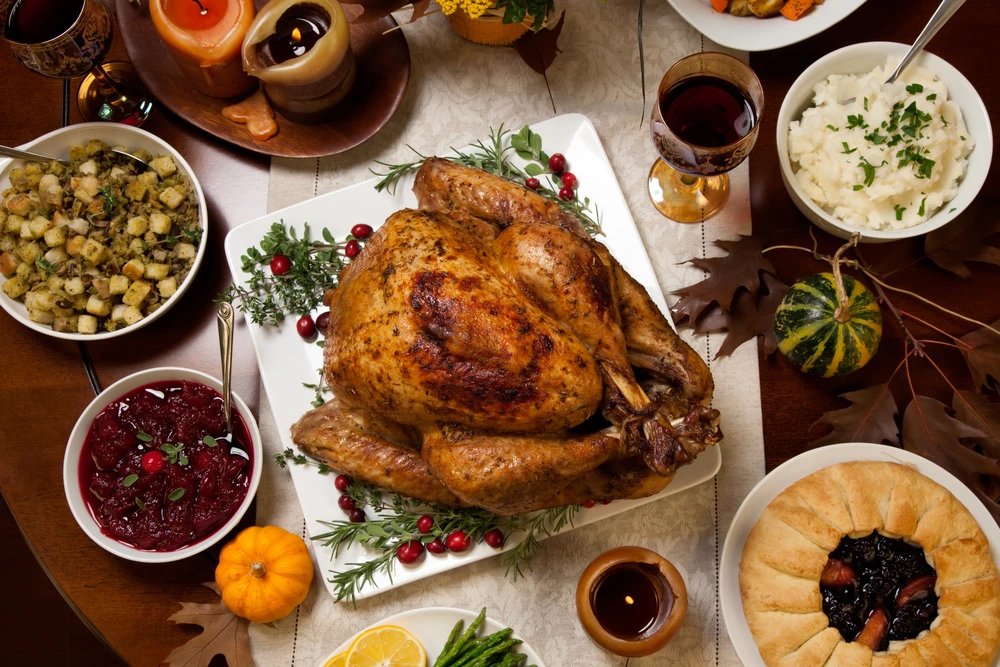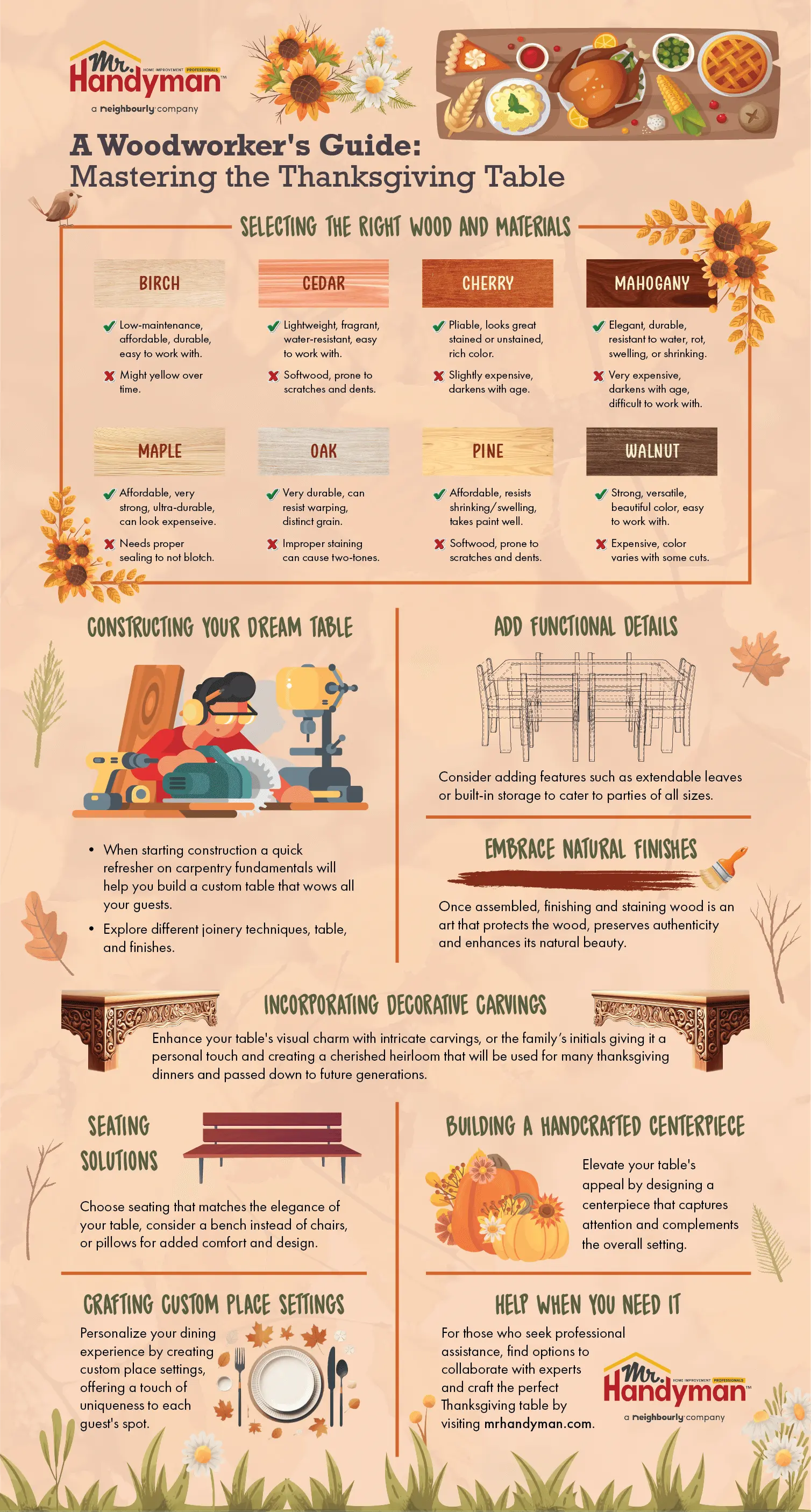What You Need to Build the Perfect Thanksgiving Table

Are you hosting Thanksgiving this year? Get ready to blow your family and friends away with the perfect Thanksgiving table!
Creating a beautiful table is the perfect way to welcome everyone into your home to celebrate the holiday. Use your creativity to create a warm and inviting experience for your family, friends, and guests that will enhance the feelings of gratitude and togetherness that Thanksgiving is all about.
Designing Your Ideal Thanksgiving Table
Before you pull out your tools, visualize the ideal Thanksgiving table in the center of your family’s celebration. Make a list of what Thanksgiving table ideas complement your personal style and create the holiday vibe you’re going for.
When designing your new table, incorporate your ideas together in a way that considers elements like shape, size, and seating capacity.
Obviously, if you’re hosting a large number of people, you’ll want a table that will easily accommodate everyone comfortably. For a more intimate Thanksgiving experience, a smaller table is ideal.
Selecting the Right Wood and Materials
Once you’ve designed your Thanksgiving table and you know what size, shape, and capacity you want, it’s time to explore different types of wood and material. When starting your selection process, look for wood that fits your style and budget.
Here are a few types of wood you may want to consider and the pros and cons of each:
Oak -
A very durable, grainy hardwood. Comes in 2 varieties: Red oak, which can be light brown to pinkish red in color with a water-like pattern. And white oak, which has a tiger-stripe grain with yellowish features. A good option because it tends to resist water damage.Pros: Very durable and can be cut specifically to resist warping. Unique grain patterns offer a distinctive look, which can be highlighted with a clear finish.
Cons: Improper staining can darken the wood, which may exaggerate the grain, causing it to look two-toned.
Maple -
One of the hardest wood species. This light-colored (white) hardwood may also have a reddish hue. It’s often used for making dressers and kitchen cabinets.Pros: An affordable and ultra-durable hardwood. Maple can withstand heavy use and still look great for years. Maple is often stained to mimic more expensive woods, like cherry or mahogany.
Cons: Must be properly sealed to avoid looking blotchy.
Cherry -
A hardwood that is often used to make chairs, tables, and cabinets. It has a fine, straight grain that ranges from reddish-brown to blond.Pros: Pliable and easy to work with, this wood looks great when polished after staining. Unstained, it has a natural, rich, beautiful color.
Cons: More expensive than other hardwoods. The color may also darken with age (which may be a benefit for some).
Walnut -
This straight-grained hardwood appears chocolate brown (when center-cut from a tree) to yellow (from the outer portion). It is mainly used to make headboards, ornate antique-style dining tables, and mantels. It is best finished with a clear-coated or oil to bring out its natural color.Pros: A very strong, beautifully colored, and stable wood that can be carved into intricate designs.
Cons: A more expensive hardwood. The color of some cuts may vary from dark to light.
Mahogany -
A durable, long-lasting wood that is easy to use, with a deep, dark reddish-brown grain that many people find attractive.Pros: Naturally resists water, is rot-resistant, and is not affected by weather changes, so it won’t shrink or warp. These traits make it ideal for use in outdoor furniture, decks, and boat interiors. Holds stains well, which adds to its durability.
Cons: Limited supply makes this wood very expensive and difficult to find in a specific color. It is a dense wood that is heavy and difficult to work with when dealing with large pieces. Color will darken with age, especially when exposed to sunlight for extended periods.
Pine -
A lightweight softwood wood that can be yellowish or whitish with brown knots. Used often to create rustic-looking furniture pieces, like farmhouse-style tables.Pros: A low-cost wood that takes paint well (great for kids' furniture). Resists shrinking and swelling and develops a nice, rustic patina with age and use.
Cons: This softwood is prone to scratches and dents.
Cedar
- A commonly used softwood that is available in several varieties like western red, Alaskan yellow, Spanish, eastern red, and northern white. Has a distinctive scent that is often associated with saunas and cigar boxes.Pros: This wood is lightweight and easy to work with, and the high oil content makes it water-resistant.
Cons: Since cedar is a softwood, it’s more prone to scratches, dents, and bruises.
Birch
- Although birch is a medium-grain hardwood, it is relatively easy to work with andPros: A low-maintenance, affordable, and durable hardwood. It’s easy to work with and looks great, even without staining.
Cons: May turn slightly yellowish over time.
Before making a final decision, consider the look, durability, and maintenance requirements for each type of wood, and which option fits best with your specific needs.
Building a Handcrafted Centerpiece
Now that you’ve determined what type of wood to use for your Thanksgiving table, consider adding a special touch in the form of a standout centerpiece, a decorative tray, or a fancy candle holder.
Learning new carpentry techniques and skills may take some time, but it will add a personal touch to your Thanksgiving table that shows off your unique personality and style. It can also make for some great conversation over Thanksgiving dinner.
Crafting Custom Place Settings
In addition to crafting a table, consider whatever Thanksgiving projects you can incorporate into your plans without taking on too much at once. Creating personalized place card holders, napkin rings, or utensil caddies will go a long way in tying the entire tablescape together.
If you are an experienced woodworker, this is also a fantastic way to implement your skills into your project and lend a touch of creativity and individuality to your Thanksgiving table.
Your guests are sure to be impressed!
Constructing Your Dream Dining Table
Once you have a plan for all of your Thanksgiving projects, it’s time to start construction. If you need to brush up on your skills, don’t be afraid to dive into carpentry fundamentals! A quick refresher will help you build a custom table that wows all of your guests.
There is a lot that goes into constructing a gorgeous Thanksgiving table. Explore different joinery techniques, table legs, and finishes that complement your desired aesthetic.
Adding Functional Details
Since you are creating your Thanksgiving table from scratch, think of everything you wish you had when serving a big dinner party. You can enhance it with functional features such as extendable leaves or built-in storage.
If you are hosting parties of all sizes, extendable leaves might be a great addition to your design since it allows you to make your table as big or as small as you need. When you combine practicality with design, it will create a table that looks beautiful but also one that adapts to your unique needs.
Embracing Natural Finishes
Even after it’s assembled, your Thanksgiving table isn’t complete with a stained finish, and this can be the perfect time to discover the art of finishing and staining wood in a way that will showcase its natural beauty.
Choose a finish that protects the wood, preserves its authenticity, and enhances its natural beauty.
Incorporating Decorative Carvings
When it comes to making your Thanksgiving table your own, try your hand at decorative carvings. Depending on the type of wood you choose, you can embellish your table with intricate designs and details to personalize it and truly make it all your own..
Use these carvings to add character, personality, and personal touch to your beautiful new creation.
Seating Solutions
Once your Thanksgiving table is pleasing to the eye, it’s time to build the seats for your guests. Depending on your preference, you can choose between chairs and/or benches.
As you explore different carpentry options, consider designs that complement your Thanksgiving table’s style while ensuring you have enough space to accommodate all of your Thanksgiving guests comfortably. Consider adding cushions to increase comfort while adding a design element to your dining room.
Personalizing for Thanksgiving Memories
Another great way to add your family’s unique style to your Thanksgiving table is to personalize it by adding engravings or family initials into the table or chairs you build.
These personal touches will create a cherished heirloom that is used for many Thanksgiving dinners and passed down to the next generations.
Help When You Need It
Building a table that can be enjoyed for Thanksgiving meals and other holidays for years to come is a great accomplishment. Even greater and more important are the people you gather around it.
If you’re gearing up for the holidays and notice that your home needs a little TLC, reach out to your local Mr. Handyman® for help.
Our handyman services will help you complete all the projects on your to-do list. Whether it’s home maintenance, repairs, or renovation, our experienced pros can help you get it all done.
Choosing Mr. Handyman means all our work is backed by the Neighborly Done Right Promise™, which means the job will be done right the first time. Make sure your home is ready to host holiday gatherings, call or schedule an appointment with Mr. Handyman today!
 Click to call
Click to call


